Home>North America>Life of AB Gregory
Chapter 6: First Visit to Mount Athos
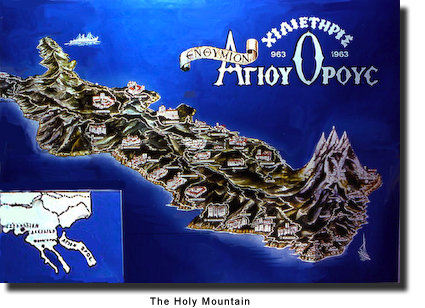
Not long after George‘s arrival, he and Fr. Panteleimon visited their spiritual fathers on Mount Athos. It is hard to put into words the feelings that come over a man when he first sees the Holy Mountain. One is filled with awe, wonder and reverence when one sees the portion dedicated to the Virgin Mary. This huge peninsula only seems huge. In reality it is three miles wide at its thinnest point and thirty miles long!
The fathers they visited were the Elder Arsenios, the co-struggler of the Elder Joseph the Cave-Dweller, and their disciples Fr. Haralambos and Fr. Ephraim. These last two had attracted approximately twenty disciples at that time. They lived in the part of Mount Athos which is known as New Skete.
When the travelers arrived at New Skete, they met the novice John who had arrived much earlier.
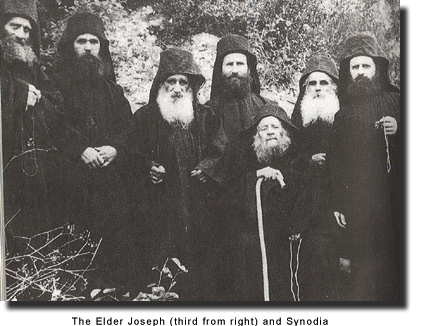
The young George beheld the way of life at this skete very closely, and as would be natural to any young man, he considered if he had the strength to live the life of an Athonite monk there. He understood, however, that this would be too difficult for him, considering the language barrier. The three stayed there for about one week, living as the other fathers did. Rising early in the morning, while it was still dark, it was George‘s job to help Fr. Arsenios climb the precarious path to the church at night. He would do this by pushing him from the back.
After a day or so, it was decided to visit the Portaitissa icon which was on the other side of the Holy Mountain. While at the icon of the Portaitissa, Fr. Panteleimon had prepared to bestow upon novice John his black clothing. It was the monastery rule that a novice would remain six months in secular clothing, and only then receive the black. This rule was dispensed with for the young John so that he could receive his black before this holy icon, even though the young George had come to the monastery well before John. It was explained that while John was at the seminary, he was still somehow connected to the monastery, and therefore the time at the seminary was counted as time at the monastery!
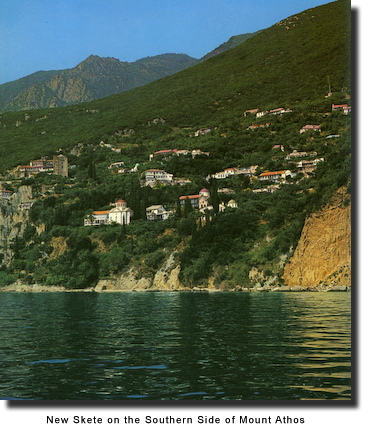
This trip would be taken by a kayaki, a small fishing boat, which at that time could be rented by anybody who wished. Father Arsenius also desired to accompany them. So news went around New Skete that on a certain day, the fathers were going to rent a small fishing boat and travel to the Monastery of Iveron, going around the tip of the Holy Mountain. This was going to be a very exciting trip because to visit the Portaitissa icon is no small event in the life of anybody.
When the day came, the passenger list had increased, because as news went around others asked if they could come. When the small boat arrived from Ouranoupolis, the port just outside Athos on the south, which was some twenty-five miles away, it had already become mid-morning. It was a small boat with a single motor, but it had a tall mast in the middle which had a sail on it. The sail was wrapped around the mast when the operator or captain was using his motor. It went very slow since it was a fishing boat. It had just a walk path around the sides of the boat with a protruding center where one can walk down inside. The motor was below the deck, so everybody stood on the pathway and leaned up against the cabin which protruded up in the middle of the boat.
Father Arsenius, of course, was the oldest and most respected of the elders who came on this trip. He planted himself on the side and put his staff on the side of the boat which forced his chest up against the cabin. There was also with him the Elder Joseph‘s blood brother, Elder Athanasios, Fr. Panteleimon, novice John, and then there came a very quiet young monk in his thirties, whose name the young George did not know. Lastly there was George, along with the captain.
When this little group of pilgrims set out, they disembarked from the south side of the Holy Mountain. The waters were quite calm. As they passed certain caves along the cliffs, they all of a sudden heard music, to the amazement of George and the others. It was Greek music, and the only explanation the monks had was that radio waves were somehow trapped in the caves and were sounding out in such a way that one could hear them. This only lasted about thirty seconds.
As they passed through the area of Karoulia, the tip of Mount Athos, the owner of the ship saw the white-capped waves of the sea. It was very dangerous and he began to use bad language, swearing and threatening to turn back. If he did that, however, he would not get his full payment, but if he proceeded, he thought he would put the little boat into jeopardy. When everybody saw the white crests and the waves, fear overtook them all.
The captain proceeded a little bit into the rough seas and then continued to swear. Fortunately it was all in Greek and George was the only one spared from his vulgar language. As he continued into the rough sea, the passengers were holding on almost for dear life. If he approached a wave in an improper way, the wave would splash onto the boat. It seemed that with every wave that hit the boat, the owner was muttering something.
Then to their astonishment, the sail that was wrapped around the center mast began to unravel itself. It was not tied down properly. As they passed the Great Lavra, the situation grew worse. The concern of the owner was quite great in that he couldn‘t leave the rudder to reach the unraveling sail. One could see it on his face and hear it on his lips. Not one of the passengers could reach over the cabin to get close to the mast to hold the sail either.
When George saw what they were trying to do and understood the necessity that the sail should be wrapped up, he waited for the boat to be tipped in a certain direction and then he jumped up onto the cabin top. He held onto the mast as his only support and then wrapped the sail around the mast and then proceeded to tie it. When some saw what he did, they wondered how was he would safely descend on that walkway without missing the boat. However, he waited for the boat to tip in another direction and then jumped down safely. When the owner of the boat saw what George did, the first smile that day came over his face and all further cursing was abated.
As they proceeded along the north shore, they came to their destination of Iveron, but the waves were so high that the owner did not even want to go near the cement pier for fear of damaging the boat. He decided to continue up the north side of the Holy Mountain and came into the cove that made the harbor of the Monastery of Vatopedi. All this time Frs. Arsenius and Athanasios were quietly holding their staffs being supported thereby against the cabin and were saying their Jesus Prayers. In the Vatopedi Bay the sea was very calm and the captain was able to gently approach the cement pier and all disembarked.
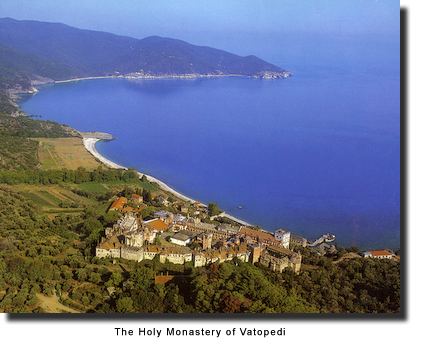
It was lunch time. Father Arsenius did not wish to even enter the Monastery of Vatopedi, but stayed on the pier. When asked the reason, he said that because the monastery commemorates the Ecumenical Patriarch and is idiorrhythmic, and because the monks eat meat and smoke cigarettes, he did not want to enter but preferred to stay outside and have his lunch there. This greatly impressed the young George as he observed the strictness with which the fathers of New Skete, and especially the disciples of the Elder Joseph, at that time held to the holy traditions and rejected the new heresy of Ecumenism.
Father Panteleimon, however, decided that he was going to go in, and he took the two young novices to see the catholicon (main church) and ask to venerate the relics, if they would be presented to them. This monastery was truly like a small city. The courtyard was vast. The catholicon made one breathless as one beheld the glory of Byzantium that was poured into the adornment of this church. This monastery housed the relic of the belt of the Virgin Mary. Indeed it was dedicated to the Dormition of the Virgin Mary.
When the relics were brought out all made prostrations and venerated the holy things. Everything was done somewhat quickly so that they could eventually enter the Monastery of Iveron before the chapel of the Portaitissa was closed at two o‘clock. This was the purpose of the trip, but other circumstances brought them to Vatopedi instead. So the first major monastery that the young novice George entered at the Holy Mountain was the Monastery of Vatopedi. Little did he know that in the future he would found a monastery also dedicated to the Dormition of the Mother of God.
Little did he know also that this very monastery of Vatopedi would have one day as its abbot one of the very disciples of the Elder Joseph. He was called Joseph the Younger, and to obtain the abbacy of this monastery, he had to abandon the very traditions and strictness which were exhibited by the Elder Arsenius on this trip. He had to agree to commemorate the Ecumenical Patriarch, and by doing so he lapsed into the heresy of Ecumenism.
They disembarked from Vatopedi in the calm waters of the cove, but immediately outside of the cove they were again in the violence of the sea which they had experienced on the way. Soon they approached Iveron again and when the owner of the ship saw the waves still beating against the cement pier, he did not wish to approach. However, after considerable yelling back and forth in Greek, with great fear, the owner of the boat approached the side of the pier. The side of the boat was rising up above the pier and was going down below the pier with the waves. He stayed a good two feet away, all the time muttering something. The younger monks and novices jumped off onto the pier first as the boat was descending. The elder, Fr. Arsenius, was the last to leave the boat but made it onto the pier in a very safe way. The boat captain did not want to remain close to the concrete pier, so he went out a little and just went around in circles until the passengers came back.
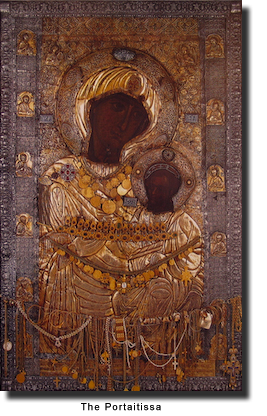
Father Athanasios went ahead to be sure that the chapel was not closed, and he came running back to announce loudly, “Glory be to God! Hurry, everybody! We made it! They are going to keep it open, even though it is time to close it.” And so they all rushed up to the gate of the monastery and then into the courtyard and then into the small chapel of the Portaitissa. There George saw for the first time the awesome countenance of this large, majestic icon of the Mother of God of the Portal. Everybody did their prostrations and kissed the icon with much reverence and compunction. Then, Fr. Athanasios, who was noted for his chanting, intoned the hymn, Axion Estin. He chanted it with much fervor as everyone stood with tears in his eyes.
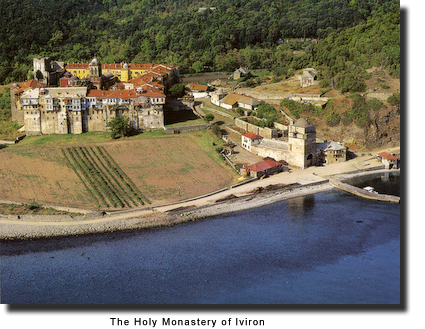
They had all undergone quite an ordeal to meet the Portaitissa, and now as they stood there, to their amazement, the lamp over the icon began to move of its own accord. It swung from left to right. This happens on various occasions and the monks are not of a definite opinion as to why it occurs. Some say that the Virgin Mary is pleased, and others say the Virgin Mary is giving a warning to the monks of the Holy Mountain. Young George attributed it to the fact that the holy Elder Arsenius had made this truly arduous trip to venerate the Virgin Mary, and the Virgin Mary was showing her appreciation. This was not the first time the Queen had comforted the Elder Arsenius.
After all kissed the icon again, the party of pilgrims left Iveron and went back to the pier to see if the man had remained or had left. He was still going around in circles and was quite agitated because in his opinion, the sea had become worse. He came nigh to the pier and as the boat would make its ascent, one by one, everyone got in. Then they proceeded to go home around the tip of the Holy Mountain, hearing a few radio signals on the way. Then, as they passed Karoulia, the southern tip of Athos, the sea became calm all the way back to New Skete. Everyone disembarked, giving thanks to God that there was no mishap.
Needless to say, everybody was exhausted from this trip. It was eighteen and a half miles to the monastery of Iveron, and then it took another eight miles to reach Vatopedi. The complete trip was fifty-three miles in the little kayaki.
While in New Skete, they attended the Liturgies that were celebrated by the fathers. George would be a help to the Elder Arsenius in these not-too-long treks from the kelia of the Elder Joseph to the church where the Liturgies were held. Young George would be right behind the Elder Arsenius and push him up the narrow pathways leading to the church. This was all done at night by flashlight because the Liturgies they had took place at midnight. The fathers would do vespers in the afternoon and the remainder of their prayers in the forest, but separated from one other so that they would not hear another father doing his prayers. And they would continue doing their prayers until midnight. At midnight they would gather for the Divine Liturgy. It was very inspiring for George to see all the fathers, both the old elders and the young monks, gather together to celebrate the Divine Mysteries. No bishop was commemorated during these services by name, but only the “Orthodox Episcopate” because the zealots would be persecuted if they commemorated openly any bishop other than the Patriarch of Constantinople.
The older fathers were very kind to George and gave him a place inside the small chapel, whereas most of the monks were outside. There he observed how all the fathers, especially the elders, conducted themselves during the holy Liturgy. The Elder Haralambos was serving. He had a very soft, high pitched voice and, one may say, even barely audible, but it did not matter. It seemed that everybody there knew the Liturgy by heart. They knew all the petitions, and at the proper time, all the responses. When time for Holy Communion came, everybody very devoutly partook of the holy Mysteries, the elders first, of course, and then the young monks filed in from outside, and at the end, young George also partook of holy Communion.
After the Liturgy everybody filed back to his cell, and now the young George would go behind Fr. Arsenius, only this time instead of pushing him, he would hold his belt from behind and restrain him from going too fast downhill and possibly injuring himself.
During these services, and even throughout all his encounters with the Elder Athanasios, George observed him acting in a strange way. (The Elder Athanasios was the biological brother of the Elder Joseph. He had followed his brother to the Holy Mountain to struggle in the monastic life.) Whenever novice George and anyone else approached a threshold, the young George would not go through first, since he was the last novice, thus respecting all the monks, and especially the elders. This, however, did not work when it came to the Elder Athanasios. Father Athanasios would not pass through any doorway first if the young George was present before him. George had to pass through first. When he did this the first or second time, the young George obeyed the request of this venerable father, thinking that the elder was being humble and perhaps even testing the obedience and humility of the young novice. However, he did this continuously and only with the young George. No matter how many entreaties the young novice would make to let the elder go first, he would not go before the young George. Even when the other fathers told him to pass through before the novice, he would not do it. It was only many years later when this young George became a priest and even a bishop, did some wonder whether the brother of the Elder Joseph knew that this young man would eventually have such a high dignity in the Church.
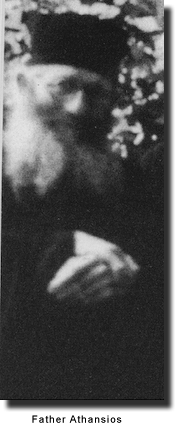
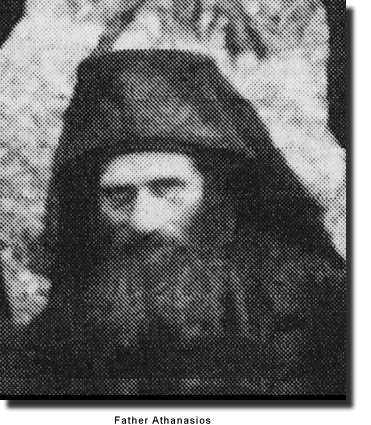
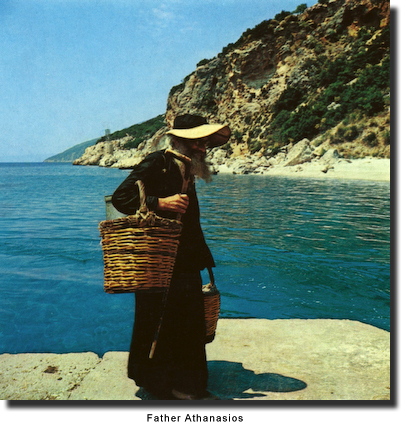
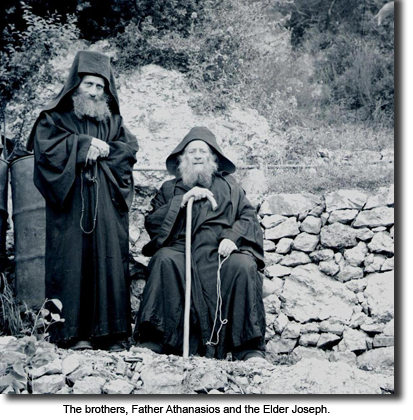
The kelia of the Elder Joseph and the Elder Arsenius at New Skete looked over the sea, and the morning view was very stunning. From New Skete to the south, one came first to the sketes of St. Anna and Little St. Anna, and then to the skete of Katounakia.
One day, the three pilgrims decided to walk to the skete of Katounakia, and there to visit the Elder Nikephoros and his two disciples, Frs. Ephraim and Procopius. It was said that Fr. Nikephoros was a very strict elder and because of the obedience of Fr. Ephraim, Fr. Ephraim was more renowned than his elder, and some say even more holy. This, however, seemed to be not as true as one would hope. Many times the Greeks have a weakness to make up stories, especially about people‘s alleged holiness, and as is often the case, once a story starts, it gets repeated and magnified and blown completely out of proportion. Others hear it and relate it in a different way, and it becomes another story, and soon someone has a reputation of being one of the greatest wonderworkers the Church has ever known.
To some extent, this is what happened with this Elder Ephraim of Katounakia, and it‘s most definitely what happened to the other Fr. Ephraim, who took control of Philotheou Monastery, and who could not remain on the Holy Mountain, but resides in America. The three pilgrims came to Katounakia for a visit, and the meeting with Fr. Ephraim of Katounakia was quite eventless, other than the fact that Fr. Ephraim seemed like a reluctant prisoner, not one rejoicing in obedience. There was quiet talking, all in Greek, greetings and goodbyes.
The outcome of this occasion was in stark contrast with the words of Fr. Ephraim in his book which recently appeared. Ironically, the book was named Obedience is Life: Elder Ephraim of Katounakia, and in this very book this alleged Elder Ephraim records that he later forced his elder to begin once again commemorating the Ecumenical Patriarch at a time when the Ecumenical Patriarch had openly espoused the heresy of Ecumenism. He thus recorded his own blatant disobedience in a book supposedly teaching obedience. The Elder Nikephoros, it is said, grieved very much that his disciple, Fr. Ephraim, had forced him to do something against his conscience. Three years before he died, however, the Elder Nikephoros returned to the church.
The travelers left Katounakia and returned to New Skete by foot. Finally it was time for the departure of the American visitors. Before they embarked upon the boat home, they all went to the Elders Haralambos and Ephraim, receiving their blessings, and lastly they came before the great Elder Arsenius. The last blessing from the Elder Arsenius was very moving for the young George. The young John bowed his head under the hands of the Elder Arsenius, who made the sign of the Cross over him and prayed. Next the Elder Haralambos looked at George and motioned with his hand to put his head under there too, whereupon George also bowed his head. Father Arsenius then laid his hand upon the head of George and made the sign of the Cross, and he recited prayers over both of them. Father Arsenius was not a priest, but because he was the elder of this thriving group of monastics, his blessing was like the blessing of Jacob over his children. It was only later that the young George learned that Fr. Arsenius had then stipulated that, “When the young George is tonsured, his name was to be made Gregory, after St. Gregory Palamas.” This was first told him over three years later, after his tonsure.
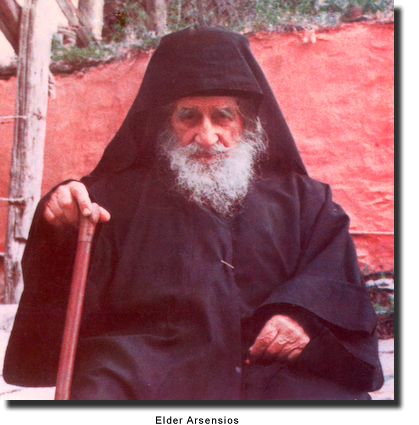
The American guests then bade farewell and departed the Holy Mountain. George‘s experience there was very profound, and as he looked upon the Holy Mountain while departing, he could only wonder if he would ever return.
|
Archbishop Gregory Dormition Skete P.O. Box 3177 Buena Vista, CO 81211-3177 USA |

|
|
|
Copyright 2011 - Archbishop Gregory Last Updated: July 12, 2011 |
